
Teaching Reading in the Classroom.
Survey of Historic Methods and Curricula.
Public schools in the U.S. generally adopt standardized curricula for the teaching of reading. Teachers guides are passed out with workbooks, assessment quizzes, and practice sheets. To remain in good standing teachers don't deviate from their asigned curricula and teaching methods.
Naturally school districts don't want to be sued later by graduates who can't read, so uniform methods for each grade level are quite reasonable. They enable parental complaints to be answered from behind the shield of legal responsibility. In the case of someone failing to learn to read, courts would agree that "the finest teachers were using the most highly appraised curricular methods and it's truly unfortunate that a few children - maybe yours perhaps - never achieved reading skills."
DROP-OUT STATISTICS:
There are some schools where almost everyone learns to read, but others where the statistics are so bad they're embarrassing. It's self-evident from numerous surveys that forty to forty-five percent of the children who enter public school each year will not learn to read - on average. These unfortunate persons migrate upward through the system and after 9 or 10 years they usually drop out of school. Being two years older than their peers, they look for low-paying jobs that don't require reading skill.
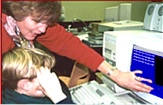 Teachers shouldn't always be blamed for this sad outcome - although when a child fails to learn to read, his or her teachers are always the nearest scape-goats - very visible and vulnerable. There are dozens of social and cultural factors involved here so blame can't be pointed in any single direction. Unfortunately, the U.S. has been free-falling into illiteracy for many years. As of 2008, about 40 million people are unable to read English street signs, maps, or want-ads. Many can't speak English at all.
Teachers shouldn't always be blamed for this sad outcome - although when a child fails to learn to read, his or her teachers are always the nearest scape-goats - very visible and vulnerable. There are dozens of social and cultural factors involved here so blame can't be pointed in any single direction. Unfortunately, the U.S. has been free-falling into illiteracy for many years. As of 2008, about 40 million people are unable to read English street signs, maps, or want-ads. Many can't speak English at all.
ILLITERACY FREE-FALL:
The numbers worsen each year by about two million additional persons who either dropped out of school or who appeared as new immigrants, often unable to read or write their native languages. They're unlikely to pay for English reading lessons. Worse, there are very few incentives for immigrants to learn to speak English (not to mention reading it) even though they've migrated voluntarily to an English-speaking country.
During the years of accumulated illiteracy, various methods of teaching reading have been swapped in and out by administrators and by curriculum committees. Whatever the currently-prescribed method is, it always has to be applied obediently by teachers. No experimentation or deviation is allowed regardless of whether pupils are learning to read or not. Schools naturally prescribe this year's method of guiding children into literacy even though it may have produced disappointing results for several years.
SEEK OPPORTUNITIES TO APPLY ALTERNATE METHODS.
However, flexibility is sometimes granted to language-lab administrators and to teachers who're involved in remedial reading. These teachers may benefit from this review of historic methods of teaching reading. Each method has been measured for effectiveness, then discarded, then reinstated, challenged, and often dropped again.
Not all of the historic methods represent failed practices. If you're a teacher who's seeking new, effective teaching methods, be sure to review the historic methods in this web page, and also two other web pages where new technologies and highly successful methods are presented. They are:
Free Software and Phonic Materials for Teaching Reading A new experimental method that encourages "invented spellings" that are instantly corrected by the computer. Corrected words are then spoken from computer speakers providing immediate feedback without incrimination or guilt. A list of 7,000 special words are identified and provided as the basis for curriculum planning. Free - no costs.
Description of the Turbo-Reader Curriculum and Workbooks Used to teach children to read before they enter public school - but now used by literacy volunteers with great success. Created by Phyllis Schlafly. There are directions to her web site. Quality workbooks. This method can be used "after hours" by volunteer reading specialists. Phonics-based.
HERE ARE EIGHT TEACHING METHODS that have been tried in the past.
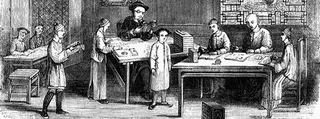 DISCLAIMER: The teaching of reading ought to be unnecessary. Persons born in Austria, Germany, Holland, Switzerland, Finland, Spain, France, and Denmark learn to read with almost no instruction because their letters are used consistently with rigid reliability. The written form of their words uses lettersto reliably represent the sounds that should be spoken or imagined. Just as children learn to speak the words of those languages, they also learn to read them because the spelling and use of letters is reliable. Their dictionaries don't have diacritical markings like "deteriorate" di-t`e.r^i-o-r`aet.
DISCLAIMER: The teaching of reading ought to be unnecessary. Persons born in Austria, Germany, Holland, Switzerland, Finland, Spain, France, and Denmark learn to read with almost no instruction because their letters are used consistently with rigid reliability. The written form of their words uses lettersto reliably represent the sounds that should be spoken or imagined. Just as children learn to speak the words of those languages, they also learn to read them because the spelling and use of letters is reliable. Their dictionaries don't have diacritical markings like "deteriorate" di-t`e.r^i-o-r`aet.
Indisputably, the erratic, confusing spelling of English words defeats the basic purpose of a spelling system. There are hundreds of scholars, writers, and thoughtful observers who explain this with thousands of examples, although it should be obvious to everyone. See bibliographic notes elsewhere.
Spelling lessons consume a part of almost every school day in the U.S. and this goes on and on for years. Enormous energy and time is given to struggling spelling students, all because spelling simplification of the type that would enable us to spell words without reaching for a dictionary or spell checker - that hasn't been popularized despite the efforts of the International Reformed Spelling Society, and many advocates. The battle against illiteracy will be solved when a strategy for simplifying the spelling of our words is popularized.
Meanwhile, scholars have tried valiantly, inventing many teaching methods, in the hope that all children could be taught to read. John Dewey observed that what ever methods have been used to teach English reading, a few children always struggle in vain, never achieving literacy. The methods that follow were outlined by Stanley Sharp in his book "The REAL Reason Why Johnny Still Can't Read." Here they are updated and summarized.
THE ALPHABET METHOD
Teaching the names of alphabet letters (learning your ABCs) was once thought to be adequate to lead children into the reading of words. This was expressed in 1620 when flash cards, booklets, and classroom slates were used to teach the letters of the alphabet in rural America.

Today teacher's stores are stocked with a wide variety of flash cards big and little that can be used by parents or teachers when teaching the ABCs. As a method for teaching reading "The Alphabet Method" is no longer promoted. If a child or adult comes to school without knowing the English alphabet, this deficiency is remied as a separate topic.
Colorful flash cards today generally look like the insert here. Since sample words are shown with each alphabetic letter, the learner is prompted to repeat those words often, causing parents to falsely imagine that the pupil has learned to read. A normal child will soon be able to say with confidence "Y YES BYE DRY LADY ." Each box to the right represents a single flashcard.
The words show that the letter "Y" can be used at the beginning of a word, or within the word, or at the end of a word, and the word can be of various lengths. Unfortunately the child or adult will quickly be able to recite those words from memory. The recitation, however charming, has not advanced the learner into understanding that the letters are meant to signal sounds that ought to be uttered.
This method was popular in early America and the spelling books from 1620 to 1700 generally used this method. The McGuffey Readers in the 1800s migrated into short sentences with occasional rhyming words which could be used creatively by parents and teachers in a variety of teaching styles.
Being able to recite alphabet letters is necessary - a precondition before advancing into reading. Today they're often learned through bouncy music on cassette tapes, or with DVDs designed for that purpose, or by clever use of flash-card games, but "the Alphabet Method" is no longer thought to be a valid way to lead a person into the sounding out of syllables nor does it reveal the phonetic basis for English orthography which is the basis for a person to read eventually with integrity.
THE WHOLE WORD METHOD
In this teaching method, learners are expected to look at the general appearance of words. Then from the shape of the word's appearance,the pupil is expected to memorize the sounds that should be spoken. The goal is for learners to see each word as a little picture and associate the teacher's spoken word with the little word-shapes on the page.
Various amounts of emphasis may be given to letter-sound relationships, varying from teacher to teacher. But, to obediently use this method the instructor is not expected to waste time connecting syllables with sounds. Chinese people learn and gradually memorize their characters in this matter although it takes a life-time for them to master the meaning and associated sounds of 40,000 Chinese characters. This method is rarely used today because each learner eventually reaches a breakdown point beyond which new words are rarely memorized.
 Speed reading products promote this concept in an astonishing manner, sometimes exhibited on TV to the amazement of audiences. The sales pitch is that your "photographic memory" can be expanded and sharpened if you buy these speed-reading products. The host then receives sheets of typewritten text from the audience - pages never seen before. Then he focuses on each page for 3 to 5 seconds, mentally photographing the shape of every word on the page as well as the appearance of the entire page - a mental snapshot. He proceeds through 4 or 5 pages in this manner, tapping the table when finished snapping each picture. Then he takes questions from the audience to demonstrate that he accurately retained the information on each page. An example question:, "On page three, which nation had a positive trade balance and how much was it? . ." etc Successfully answering all questions, orders are then taken with promises that you, too, can develop a photographic memory.
Speed reading products promote this concept in an astonishing manner, sometimes exhibited on TV to the amazement of audiences. The sales pitch is that your "photographic memory" can be expanded and sharpened if you buy these speed-reading products. The host then receives sheets of typewritten text from the audience - pages never seen before. Then he focuses on each page for 3 to 5 seconds, mentally photographing the shape of every word on the page as well as the appearance of the entire page - a mental snapshot. He proceeds through 4 or 5 pages in this manner, tapping the table when finished snapping each picture. Then he takes questions from the audience to demonstrate that he accurately retained the information on each page. An example question:, "On page three, which nation had a positive trade balance and how much was it? . ." etc Successfully answering all questions, orders are then taken with promises that you, too, can develop a photographic memory.
Meanwhile, the ability of learners to memorize the visual shapes of one thousand words together with each spoken word will vary from person to person. Success beyond a thousand such words would be very hard to document. Any leaner can memorize some or many words in this manner, but a breakdown occurs at some point. New words will show up that aren't in the guidebooks or on the DVD. The student has no basis for using the letters to "sound out" the likely pronunciation of new words. Early successes may be stunning, depending on the learner's motivation to "JUST KEEP MEMORIZING." At system-breakdown time, the student can then be lectured about his or her lack of motivation, psychological causes for their sagging energy, and the shame they ought to feel.
VARIOUS PHONIC STRATEGIES
The phonics method requires teachers to guide learners to think of the sound(s) that should normally be associated with syllables in each word.
In this method there will be a lot of "sounding out" exercises in which a whole classroom "sounds-out" together in accompaniment with DVDs, or videos, or Powerpoint projected exercises. The names of the alphabet letters are a prerequisite to the use of this method, but the sounds associated with each syllable are the main points of focus. A wide variety of curricula and workbooks (of varying quality) are available in teacher's stores, and in the publication lists of many publishers.
It's probably safe to say that wherever this method has been dropped by a public school, it's usually reinstated within seven to ten years. That's a long enough span for parents to wake up to the alarming drop in reading skills that follow most other teaching methods. The falling success rates become visible as students percolate up to graduation.
The Phonics Method has been abandoned time and time again. The most famous swap-out occurred twelve years ago in California where competing methods were adopted for math and reading. Phonics workbooks and materials were all tossed out. One decade later they were reinstated. Local newspapers stated parents' outrage - "We have new math kids that can't count, and whole language kids that can't read. "
What's not to like about the phonics method? First, it was - until now - very hard to find beginner's English words that actually use letters consistently. The solution then was or is to cheat a little bit and prepare beginner's word lists with misspelled words - words revised to be in phonic format. Phonic words use letters with careful consistency such that if a "J" sound is needed in any word, the letter "J" will be used. So phonic words like EXAJERATE will never show the confusing EXAGGERATE spelling. Workbooks are then filled with several hundred English words appropriate for each age level using the "PHONIC VERSION" of 300 to 500 words that are spelled by using letters consistently, as they should be - to accurately represent speech sounds that should be spoken or imagined.
To use this method you must mentally sign a creed: Students must believe that letters can be trusted to cue the sounds to be uttered. Therefore early learners must be shielded from 80% of normal English spellings or they may never understand what letters are for. If normal English words are randomly encountered, the student will realize in a few hours that letters have no real purpose and they are unreliable. Motivation based on hope of success will be choked by end of the first class. Therefore Phonic words are required for beginning learners.

Unfortunately a little deception is required on the part of the teachers. These beautiful phonic word lists are
used from pre-school through the second grade but the children are learning words that are MISSPELLED in order to avoid the confusing aspects of English. Like putting blinders on horses, children see only a safe vision of how the alphabet is used. That limited encounter with spelling causing them to actually believe that letters can be trusted - that letters are reliable signals of what should be spoken.
The result of using a vocabulary list of words and sentences that only contain PHONICALLY-SPELLED (but misspelled words) has a good result in most cases. The child soon realizes that when a new word comes along, he or she can sound-out the syllables and get an idea of its likely pronunciation - otherwise know as "decoding." We all have to do decoding once in a while when new words show up if we wonder how they are pronounced.
Like most deceptions, they come to an end near the close of 2nd grade. The phonic spellings are gradually dropped and children are told "sorry little boy or girl. We don't actually spell words that way any more. You're older now, and 80% of our English words don't use letters consistently. You'll have some memorizing to do. Get used to it. There are few if any rules you can rely on. We lied to you. The Superintendent made me do it."
Children survive lots of adult lies. Momentary trauma about teacher's dishonesties and deception(s) is soon forgotten. From this, children learn that adult deceptions are ok if they serve a valued social purpose. That's why kids can't wait to grow up - they want to become teachers or politicians.
In the inset above, observe the letters "GG" in EXAGGERATE. At what point in your up-bringing did you say "OK, sometimes "G" means one thing, but other times it suggests I utter a "J" sound like in EXAJ ERATE?" Long forgotten? How about the "D" in MODULATE. You learned somehow that "D" (NOT GG) requests you to make a "J" sound as though it was spelled MOJULATE. Eighty percent of English words are confused like this, causing English to be the most difficult language to learn after the Chinese and Japanese picture-character languages. The entire battle against illiteracy is the direct result of inconsistent spelling as codified in our dictionaries. The human suffering caused by illiteracy is the strongest argument for simplified or reformed spelling initiatives.
Another common argument against the Phonic Method has to do with the flood of thoughtless word lists and classroom recitations of boring phrases that are engineered into workbooks, practice sheets, and populist products advertised on TV and Internet. Marketers capitalize on the peripheral awareness that "PHONICS IS THE ONLY PROPER WAY OF LEARNING TO READ."
Under that banner they then hire (it seems) NASA engineers and computer system mathematicians and programmers to create all sorts of tasteless exercises, noisy audio cassettes, thumping bounding music will silly rhyming, boring computer slide shows, and neon-lit electronic boxes with batteries where children push buttons to get an hourly injection of relentless words - mostly void of interesting content. Reading materials for all beginners need thoughtful content that illustrates how reading can become a rewarding and very pleasant activity.
Most objections to the Phonics Method probably grow out of lifeless curricular implementations. DOGMA: Every reading assignment from the earliest years ought to have content that draws the learner's mind into the actual content of sentences beyond the naked pronunciation of syllables. Mere syllabic drills can be thoughtlessly performed. Young children can be unfairly rewarded for just looking at words and saying them - AND THEY WILL DO IT CHEERFULLY ON COMMAND - while failing to understand the messages the phrases convey. Publishing companies: wake up - harm is done when you publish inept phonics materials - bright-colorful junk booklets, claiming to be the latest teaching materials.
THE LINGUISTIC METHOD
In this method teachers adhere to the Phonic method above, but they try to avoid the deception of deliberately showing misspelled words to children or other learners. Instead they search for those few English words that are already spelled consistently and they use only those words to instill the concept that letters are trustworthy indicators of sounds to be uttered.
Unfortunately, until now, their lesson plans had to be quite short since English is riddled with arbitrary spellings. Nor is it easy to isolate words that are quite phonically pure. In the end children still have to make the transition to the majority of words that are spelled in 36,000 random configurations of letters - illustrated briefly in the graphic above. But, the shortage of pure phonetic words has limited this otherwise valid approach. A new resource, however, greatly resolves the scarcity of naturally-occurring phonic words.
Elsewhere on this web site you can read about the pioneering work of Dr. Edward Rondthaler. Devoting 25 years exclusively to his spelling-simplification project, he developed a phonic version of the most-used 46,000 English words. By careful analysis and use of powerful computer tools, he was able to create a phonic spelling version of these 46,000 words. You can download it or review it more thoroughly in other web pages herein.
After the publication of his dictionary of simplified spelling (Unfortunately titled "AMERICAN SPELLING") it was eventually observed that 7,000 of the words couldn't be simplified. They couldn't be made more accurate because they were already in phonic form.
On this web site the ALC has released two contributions that support the Linguistic Method. FIRST, a new list of 7,000 normal English words is available without cost. These words are PHONICALLY QUITE PURE. They're already in phonic form - an accident of the language. They use letters consistently. Somehow these words escaped damage. They don't have to be misspelled to achieve phonic status. If you use these words to create sentences and worksheets, you'll never have to say "I'm sorry" as was described above. You can download the list for printing here.
Baseline list of 7,000 phonic words in alphabetic order (PDF file)
A SECOND NEW RESOURCE is a starter list of sentences for use in practice worksheets. These sentences are simple and quite obvious as to their purpose. The vocabulary is limited to words from the phonic word list above. They aren't segregated by age group. Use these sentences as starter-templates or as suggestive ideas. It was our first attempt to build such sentences and you can probably improve or enlarge the collection. Download the file in either PDF or RTF rich text format.
Sentences for Student Assignments (PDF file)
Sentences for Student Assignments (RTF-Word file)
While not required, if you use part or all of these word lists in publications, please reference this Web site which is http://AmericanLiteracy.com .
THE I.T.A METHOD (INITIAL TEACHING ALPHABET)
This method has been promoted with dozens of variations. Since English tries to signal us to make 42 various speech sounds by using 26 alphabetic letters, some linguists naturally suggest that we simply need more letters to work with. THE ITA introduces about 12 new symbols or characters that designate our speech cues more accurately . By having these extra characters a reader more accurately knows what sounds to utter.
Purists at heart, some linguists not only wish that all words were spelled phonetically, but even then, they'd complain further that there aren't 42 letters in our alphabet so something must be done about that. In 1845 Sir Isaac Pitman and A. J. Ellis published the first book that popularized this method, titled "The Alphabet of Nature." In the book he claimed there had been 27 previous attempts to "correct the shortage of letters in the English alphabet."
Lots of other people have also placed logic above social convention. They want a letter for every English speech sound. Ignoring the slow pace of language changes, ignoring that it took 50 years for TAXICAB to be shortened to TAXI, ignoring that after 200 years, the word ALTHOUGH is finally seen as ALTHO in many newspapers, ignoring that there are social organizations like "The American Heritage Foundation" whose members pay to protect English and our current spelling standards, ignoring that other countries publish lists of words that they approve for more accurate spellings, ignoring that college professors are expected to red-circle every misspelled word on papers, still these purists hope against hope that everyone will someday convert and use their bigger alphabets. Will we cheerfully buy new computer keyboards with their extra letters? From the past - here are a few people who promoted adding letters to the alphabet: George Bernard Shaw, Dryden, Wordsworth, Benjamin Franklin, President Theodore Roosevelt, and others.
In fairness, the ITA Method is an initial teaching alphabet only. It's used in similar ways to phonics methods, introducing children to a reliable system where letters are always used in reliable trustworthy ways to give us cues about pronunciation. After one or two years, children are weaned from the comfort of the ITA alphabet and nursed over to our normal spelling standards. As with phonics, little harm is done. The ITA has been used in hundreds of classrooms, both UK, Australia, and the US.
WHOLE LANGUAGE METHODS
Perhaps in reaction to the lifeless boring word lists produced by the publishing companies, the Whole Language Method demanded riddance of all wordlists and drill materials. Phonics became a dirty word. Focus was adjusted to maximize student self-esteem and to amplify all the self-satisfying pleasures to be found in listening to reading. The satisfaction of hearing new and exciting ideas read out of books was expected to attract children to become readers just by being around books and teachers who made it attractive in every way possible. Hug a book.
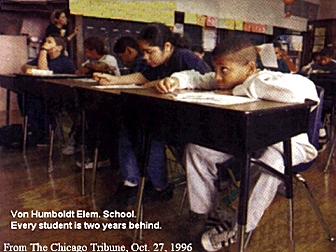
With full attention directed on student wellfare, children were asked to recount their experiences orally. Some of their words might be written large on a screen or blackboard. It was thought that seeing words from their personal experiences, testimonies, and stories would motivate them to remember what their words looked like, and they would associate the written words with their own speaking of the words.
California adopted a Whole Language curriculum for all levels in 1987 with considerable fanfare. Teachers were handed a full compliment of supportive materials, and since the method was defended brilliantly at teacher's conferences, many other states began to empower teachers to use the Whole Language Method - sometimes experimentally and sometimes fully. Most teachers remember the raging debates. Thousands of books and articles were published, praising or condemning this new method.
After a decade the popularity of Whole Language crashed. In summary these problems were identified. 1) Words from children's stories usually had irregular spellings. Relationships between letters and sounds were never learned because teachers weren't expected to teach the mechanics of vowels and consonants. 2) The randomness of new words popping up each hour prevented observance of the purpose or reason why letters are there. 3) Words appeared too frequently. Variances in children's vocabulary allowed hundreds of new words to be introduced without warning or reason. 4) A lot of new words were never seen or used again. 5) There were almost no instructional guides other than inspirational stories that should be read to the class. Explanations of the mechanics underlying reading and spelling were ignored or forbidden.
Whole Language advocates made an important observation. Our boring word lists, drills, spelling bees, and uninspiring homework assignments represent a highly unbalanced environment for learning. If that's how it's to be done, it's a killing strategy - meaning it's lifeless, uninspiring, unattractive, and many smart pupils simply opt out.
Like opting out of unwanted e-mail, kids opt out saying "don't send me any more of those boring spelling-book assignments from first grade through fifth grade. No more please - unless there's some ultimate benefit, some reward, some reason for enduring these uninspiring assignments." Whatever method we use to teach reading, thoughtful teachers must learn a lesson from the Whole Language Debate. We must seek interesting and thrilling reading materials. We must make them visible and prominent.
WORDS IN COLOR METHOD
Dr. Caleb Gattegno developed a creative teaching method that gained some popularity in beginning about 1950 in the UK and 1960 in the U.S. His method required the use of 19 wall charts that were supplied to schools who also ordered workbooks and teacher guides. Children were introduced to normal English words, but color coding dictated the sounds that should be spoken or imagined. Therefore English speech sounds could be accurately signaled to children regardless of the illogical spelling a word might contain.
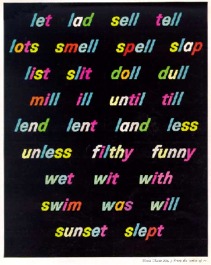
For example, wherever the "EE" sound in FEET was to be spoken, regardless of the letters in the word, that syllable was colored red. The "A" sound in ATE was colored pea green whether the letter "A" was there or not. Children easily comprehended the color codes and learned to ignore the crazy letters that couldn't be trusted anyway, Instead they were taught to speak based on the colors they saw overlaying various syllables. Eventually all such strategies have to yield to the reality of English splish-splash orthography. But, once sounds are known, color is no longer necessary and indeed the materials in the teacher's kit, except for the wordcharts, are in black and white.
Dr. Gattegno died in 1988 but he left thoughtful writings that are of interest to teachers. Do a computer search for Caleb Gattegno. He applied his method to several other languages and to the teaching of mathematics. He was an accomplished linguist, lecturer, and writer. His book related to "Silent Teaching" has many thoughtful ideas. He was a genuine intellectual, skilled in five languages and author of numerous books related to teaching. Several web sites maintain his writings and materials. For example:
http://www.cuisenaire.co.uk/literacy/wicintro.htm
The LAUBACH METHOD
The world owes much to Frank C. Laubach. In his book "Teaching the World to Read" you'll find amazing and inspirational material. Frank Laubach was sponsored to go to many countries and nations that had no written orthography for their spoken languages. He analyzed hitherto-unknown tribal sounds and their styles of speech with the goal of providing an alphabet for each tribe or nation. Then he would train teachers or leaders who soon taught their people how to read. He was known as "Apostle to illiterates." His program was called "Each One Teach one." A mystic and intellectual, he spent 40 years of his life empowering millions of the poorest, disenfranchised people in third world countries.
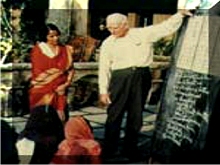
Since he had control of the requirements for each new alphabet, he could for example identify 35 speech sounds used by a particular tribe and then create an alphabet that had 35 letters or symbols representing each of their 35 sounds. No surprise - people could learn to read within a day or two. Soon these tribes and countries began producing their own literature, writing their on biographies, and documenting their governing rules and discussions. Laubach provided alphabets and taught reading to 103 separate tribes and nations.
For English-speaking countries he wrote the book "Learn English the New Way." In it he recommends a limited number of words whose spelling is changed to make it into phonic form, but he also used two diacritical markings to clarify pronunciation. He required use of the slash and the apostrophe. So essentially this method was based on the phonics method except that a few additional markings were introduced to be used only during months of introduction to reading. Laubach Literacy was founded in 1955.
Laubach Literacy Volunteers merged with Literacy Volunteers of America in 2002. Now named "ProLiteracy" they are the largest volunteer organization in the U.S. They operate also in 45 countries giving aid to 350,000 new learners at any given time. The son of Frank Laubach - Dr Robert Laubach has been an ALC Board Member since 1994. One of many web sites for the for ProLiteracy is http://www.literacyvolunteers.org/about/index.asp
IN SUMMARY
Children hear and do whatever has relevance in their lives. They demand less salad and more milk shakes perhaps. They talk and chatter because they want attention and recognition. Language lets them feel more in control of what happens next, placing themselves at the center of importance. Quoting Stanley Sharp, "When they can understand language and can express their feelings, their ideas, wants, and needs, their egos are fed; they become full-fledged individuals." These are the benefits of being able to speak English.
But the motivations for learning to write and read are driven by different needs. If a child is happy at age four and five in the absence of reading, why at age six will they develop a strong urge to master reading? Reading to the child in the home may be the best influence. If read to every day, children are more likely to desire to read themselves and children coming to first grade have a real advantage if they had enjoyable reading experiences with their parents.
School teachers, however, receive each incoming class of non-readers who may have had no pleasant home experiences, no parental guide, no understanding that there are future benefits from forced drills and worksheets. So even with phonics as the core method, new computer software and multi-media technology might be required to bring new life to the Phonics Method. It needs some spark or empowerment. It needs thrusters to elevate phonic methods to a new and higher level of interest for learners.
As a possible example, please review the new ALC "Experimental Computer-assisted Phonic Learning Strategy" designed for any age level, presented here:
Computer-assisted Reading Curriculum for Students of Any Age. [ May be slow loading ]